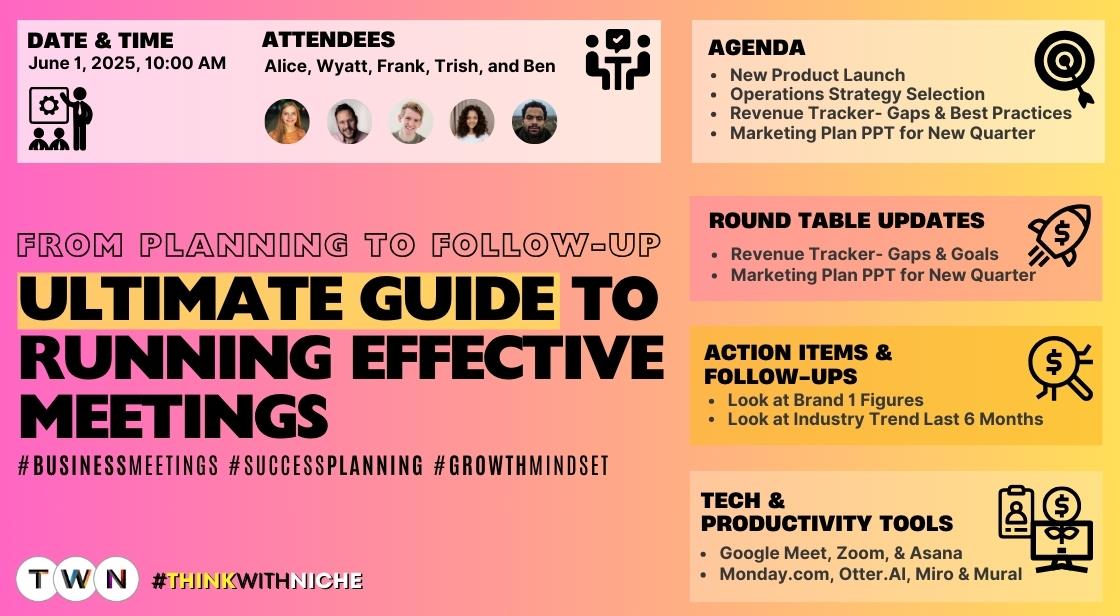Ultimate Guide to Running Effective Meetings: From Planning to Follow-Up

Blog Post
In today's fast-paced world, meetings remain a cornerstone of collaboration, information sharing, and decision-making across various sectors. However, poorly planned and executed meetings can be a significant drain on both time and resources.
Studies show that employees attend an average of 62 meetings per month, with 47% of those meetings deemed unproductive. This highlights the growing need for effective meeting strategies that maximize engagement, minimize wasted time, and ensure clear action plans are established.
This comprehensive guide delves into the various aspects of successful meetings, from pre-meeting planning to post-meeting follow-up.
Exploring factors such as meeting size, frequency, composition, motivation, and decision-making methods, it provides a nuanced view of how these elements shape the meeting landscape. With the most common being the daily workface meeting, the guide unveils how different types of meetings present unique challenges and opportunities.
By understanding different meeting types, optimizing agendas for collaboration, and fostering active participation during the facilitation phase, you can transform meetings into valuable tools for driving progress and achieving desired outcomes.
Additionally, implementing effective follow-up strategies, such as summarizing key decisions and assigning clear action items, ensures accountability and translates decisions into tangible results.
"This guide equips you with the necessary knowledge and strategies to transform your meetings from unproductive gatherings into catalysts for action and success."
Understanding Different Types of Meetings: Optimizing Communication and Effectiveness
Meetings are a cornerstone of collaboration in workplaces, schools, and communities. However, their effectiveness can vary greatly depending on several factors. This article delves into the complexities of meetings, specifically focusing on committee-style gatherings which are prevalent across various settings.
Understanding Meeting Size and its Impact:
The size of a meeting significantly influences its nature and effectiveness. This article categorizes meetings based on size:
-
Assemblies (100+ participants): Primarily focused on listening to speakers, with limited interaction expected from attendees.
-
Councils (40-50 participants): Similar to assemblies but allow for questions, comments, and occasional individual contributions.
-
Committees (Up to 12 participants): Characterized by equal participation and discussion under the guidance of a chairperson. This article focuses solely on committee-style meetings, which encompass various titles like working parties, study groups, or boards.
Beyond Size: Factors Shaping Meeting Dynamics:
Apart from size, several crucial aspects influence the nature of meetings:
-
Frequency: Daily meetings foster closer group unity compared to infrequent gatherings like monthly ones.
-
Composition: Homogeneous groups working on the same project (e.g., hospital staff) have different dynamics compared to diverse groups with distinct interests.
-
Motivation: Meetings can be driven by a shared objective (e.g., team sports), competition (e.g., budget discussions), or a common desire for success (e.g., project teams).
-
Decision-making: Methods like consensus, majority vote, or solely chairman-driven decisions significantly impact the meeting's flow and outcome.
Categorizing Committee Meetings for Enhanced Understanding:
While these five elements offer a diverse lens for analyzing meetings, certain types tend to fall under specific categories:
-
Daily Meetings: Common in collaborative settings, these meetings involve frequent informal discussions for quick decisions.
-
Weekly/Monthly Meetings: These gatherings often involve individuals working on related projects. Competition can be present, and the chairman might hold greater decision-making power.
-
Special Project Meetings: Composed of individuals whose work doesn't usually intersect, these meetings aim to achieve a specific project goal. Decisions often require implicit agreement from all members.
Ultimate Guide to Running Effective Meetings: From Planning to Follow-Up
Optimizing Meetings for Success:
Interestingly, the most common and arguably most successful type of meeting is the daily workface meeting. Shared objectives, frequent interaction, and operational demands often contribute to its brevity and clarity. However, weekly, monthly, and special project meetings present a different challenge. These gatherings are more susceptible to human dynamics and errors in leadership, potentially derailing the discussion and hindering their purpose.
Planning for Success: The Pre-Meeting Phase
1. Defining Clear Objectives and Desired Outcomes in Meetings
Start with the "Why": Before sending out the meeting invite, it's crucial to clearly define the meeting's purpose and desired outcomes. This serves as the roadmap for the entire session, ensuring everyone's time is well-spent and the discussion remains focused.
From Vision to Actionable Objectives:
-
Articulate a clear and concise objective: Don't settle for vague statements like "discuss the project." Instead, frame a specific objective like "Finalize the marketing plan for the product launch."
-
Break down complex objectives into smaller, actionable steps: If the objective is ambitious, consider dividing it into smaller, achievable sub-objectives to facilitate a more focused discussion and efficient progress.
-
Ensure everyone understands the objectives: Clearly communicate the objectives to all participants, either through the meeting invitation or at the beginning of the session. This ensures everyone is aligned and can contribute effectively.
Examples to Illustrate:
-
Instead of: "Brainstorm marketing ideas for the new product."
-
Try: "Identify and analyze 3-5 top marketing strategies most likely to resonate with our target audience for the new product launch."
-
Instead of: "Discuss project progress."
-
Try: "Review key milestones achieved in the previous week, identify any roadblocks, and outline action items for the next two weeks to ensure project stays on track."
2. Inviting the Right People for Effective Meetings
Crafting an effective meeting starts with assembling the right team. Here's how to ensure your guest list optimizes participation and fosters productive discussions:
Prioritize Relevance and Expertise:
-
Scrutinize the objective: Who is essential to achieving the meeting's goals? Only invite individuals whose direct participation and expertise are crucial for decision-making or contributing valuable insights.
-
Consider diverse perspectives: While ensuring relevant expertise is present, strive for diversity of thought and background. This can spark creative solutions and avoid groupthink, where everyone conforms to a single viewpoint.
-
Utilize technology for inclusive participation: If geographical locations or schedules pose a challenge, consider virtual meeting platforms to ensure attendance from crucial individuals who might not be able to attend physically.
Examples:
-
Instead of: Inviting the entire marketing department to discuss a specific social media campaign for a new product targeted towards Gen Z.
-
Try: Inviting the social media manager, a graphic designer specializing in Gen Z trends, and a representative from the product development team familiar with the new product's features.
Communicate Clearly and Encourage Preparation:
-
Share the agenda and objectives beforehand: This allows attendees to come prepared, familiarize themselves with the discussion topics, and formulate relevant contributions.
-
Outline expected contributions: Clearly communicate what you expect from each attendee, whether it's presenting information, offering specific expertise, or actively participating in brainstorming sessions.
Additional Tips:
-
Promote a culture of respectful debate: Encourage attendees to challenge assumptions and present counter-arguments constructively, fostering a collaborative environment where the best ideas emerge.
-
Be mindful of meeting fatigue: Avoid overly-large guest lists that can lead to disengagement and hinder active participation. Consider splitting complex discussions into smaller, focused meetings with relevant sub-groups.
Also Read: 6 Things You Need To Start A Resume Writing Business
3. Creating Collaborative Meeting Agendas
A well-structured agenda serves as the roadmap for your meeting, guiding the discussion and ensuring everyone stays focused on achieving the desired outcomes. Here's how to create a collaborative and productive agenda:
Structure with Clarity and Purpose:
-
Define clear and concise topics: Each agenda item should be easily understood and directly linked to the meeting's objectives. Avoid ambiguity and ensure topics are specific enough to facilitate focused discussion.
-
Allocate realistic time slots: Estimate the time needed for each discussion point based on its complexity and the expected level of participation. Be mindful of meeting fatigue and avoid overly ambitious time frames.
-
Outline desired outcomes: Briefly articulate what you want to achieve from each discussion point. This provides clarity and keeps the conversation goal-oriented.
Examples:
-
Instead of: Just listing "Project Update" on the agenda.
-
Try: "Project Update: Review key milestones achieved (10 minutes), discuss potential roadblocks and solutions (15 minutes), determine next steps and action items (10 minutes)."
Embrace Collaboration and Flexibility:
-
Gather input from participants: Encourage attendees to suggest relevant topics or propose specific discussion points beforehand. This fosters a sense of ownership and engagement.
-
Utilize online collaboration tools: Leverage platforms like Google Docs or Trello to create a shared agenda where participants can add topics, suggest time frames, and contribute collaboratively.
-
Maintain flexibility: While adhering to the agenda for structure, leave room for unforeseen issues or deeper exploration of crucial topics that emerge organically during the discussion.
Additional Tips:
-
Visualize the flow: Arrange the agenda items in a logical sequence that facilitates progression and builds upon previous discussions.
-
Utilize bullet points and action items: Clearly outline key takeaways and next steps for each agenda point, ensuring accountability and fostering clear communication after the meeting.
-
Distribute the agenda in advance: Provide the agenda to all attendees well before the meeting, allowing sufficient time for preparation and informed participation.
Mastering the Meeting: The Facilitation Phase
The facilitation phase of a meeting is where the rubber meets the road. Here, your role as a facilitator becomes crucial in ensuring a productive and engaging environment for achieving the meeting's objectives.
1. Setting the Stage for Success: Punctuality and Respect
-
Punctuality is paramount: Starting and ending the meeting on time demonstrates respect for everyone's time and sets the tone for professionalism.
-
Foster a respectful atmosphere: Encourage courtesy and inclusivity throughout the discussion. This ensures everyone feels comfortable sharing their perspectives and contributing to the conversation.
-
Embrace diversity of thought: Acknowledge and value the unique perspectives and experiences each participant brings to the table. This fosters creative problem-solving and avoids groupthink.
Example: As the facilitator, arrive at the meeting space early to set up and greet attendees. Start the meeting promptly at the designated time and address everyone by name. If a participant arrives late, discreetly acknowledge their arrival without disrupting the flow of the discussion.
2. Promoting Active Participation and Open Communication
-
Active listening is key: Pay close attention to verbal and nonverbal cues, acknowledge contributions, and paraphrase key points to ensure everyone feels heard and understood.
-
Ask open-ended questions: Instead of questions with a "yes" or "no" answer, formulate questions that encourage elaboration, diverse perspectives, and deeper exploration of ideas.
-
Maintain neutrality: Avoid expressing personal opinions or beliefs that might sway the discussion or discourage opposing viewpoints. Your role is to guide the conversation, not dictate it.
Example: Instead of asking, "Do you agree with this approach?", ask, "What are your thoughts on the proposed strategy and how might it impact different stakeholders?"
3. Keeping the Conversation on Track and Time
-
Respect the pre-defined timeframe: Be mindful of the time allocated for each agenda item and gently guide the discussion back on track if conversations deviate.
-
Manage tangents respectfully: Acknowledge valuable insights or concerns raised during tangents, but politely suggest discussing them further after addressing the current topic.
-
Utilize time management tools: Leverage timers, visual aids, or even online collaborative platforms to keep everyone informed about remaining time for each agenda point and ensure the meeting concludes according to schedule.
Example: If a discussion starts to veer off topic, acknowledge the raised point and suggest, "That's an interesting point, and I'd love to discuss it further after we finish addressing the current topic on the agenda."
By combining punctuality, respect, and effective communication techniques, you can foster a productive and engaging meeting environment where everyone feels heard, valued, and empowered to contribute, ultimately achieving the desired outcomes efficiently.
Ensuring Action and Accountability: The Follow-Up Phase
The follow-up phase is often the most overlooked aspect of a meeting, yet it's crucial for turning decisions into action and guaranteeing accountability. Here's how to ensure your meeting transcends words and translates into tangible results.
1. Solidifying Clarity: Summarize Key Decisions and Action Items
-
Recap key decisions: Clearly and concisely reiterate the main conclusions reached during the meeting. This fosters clarity, ensures everyone is on the same page, and minimizes the risk of misunderstandings.
-
Assign ownership and deadlines: Delegate action items to specific individuals or teams. Include clear and measurable deadlines for each action item to establish individual accountability and facilitate progress tracking.
Example: "We've finalized the marketing campaign budget. Sarah will be responsible for finalizing the creative assets by next Friday, and John will oversee the campaign launch on the following Monday."
2. Promoting Transparency: Distribute Meeting Minutes Promptly
-
Share minutes electronically: Distribute comprehensive meeting minutes within 24 hours through email or a dedicated platform like Google Docs or Trello for easy access and reference.
-
Include key information: The minutes should summarize key decisions, action items, deadlines, and ownership details. This transparency keeps everyone informed and allows for easy reference throughout the action phase.
Example: Utilize a clear and concise format for the minutes, including sections for:
* Date, time, and location of the meeting
* Attendees and their roles
* Key discussion points and decisions
* Action items with assigned individuals, deadlines, and brief descriptions
3. Driving Progress: Follow Up on Action Items and Evaluate Outcomes
-
Schedule follow-up discussions: Organize brief check-in meetings or utilize online communication tools to discuss progress on action items and address any roadblocks encountered.
-
Evaluate meeting effectiveness: Assess the meeting's success based on its pre-defined objectives and gather feedback from participants. This helps identify areas for improvement and refine your approach for future meetings.
Example: Two weeks after the marketing campaign meeting, schedule a short virtual check-in to discuss progress on creative assets and campaign launch preparations. Use this opportunity to address any challenges and ensure everything is on track for a successful launch.
Embracing Technology for running effective meeting
Beyond the fundamental strategies outlined in this guide, leveraging technology can further enhance the effectiveness and efficiency of your meetings. Here are some additional tips to consider:
1. Utilize Collaborative Platforms:
- Manage action items: Platforms like Trello or Asana allow for creating, assigning, and tracking action items within a shared space. This fosters transparency, accountability, and facilitates easy progress monitoring.
- Facilitate brainstorming: Online whiteboarding tools like Miro or Mural enable real-time collaboration on ideas, fostering creative problem-solving and capturing diverse perspectives visually.
- Streamline document sharing: Cloud storage platforms like Google Drive or Dropbox centralize access to meeting documents, presentations, and notes, eliminating the need for email attachments and ensuring everyone has access to the latest versions.
Example: Utilize Trello for your marketing campaign meeting. Create a board with lists designated for "To Do," "In Progress," and "Done." Assign specific action items for each stage of the campaign to relevant team members, set due dates, and utilize the comment feature to provide updates and clarifications.
2. Enhance Remote Participation:
- Utilize video conferencing: Platforms like Zoom or Google Meet enable seamless communication and collaboration for remote participants. Encourage video usage to enhance engagement and facilitate non-verbal communication.
- Leverage live transcription and translation: Tools like Otter.ai or Google Meet live captions provide real-time transcriptions, allowing participants to focus on the discussion while having the content readily available for reference. This is particularly helpful for individuals with disabilities or those joining from different languages.
Example: Utilize Zoom for your weekly sales team meeting with remote team members across different regions. Encourage everyone to use video conferencing to foster a sense of connection and enable non-verbal cues. Employ a live transcription tool to assist participants following the conversation and capture key points for future reference.
3. Embrace Asynchronous Communication:
- Utilize task management platforms: While meetings are valuable for discussions and brainstorming, consider utilizing project management tools like Asana or Monday.com for assigning tasks, sharing updates, and tracking progress asynchronously. This frees up meeting time for focused discussions requiring real-time interaction.
Example: Utilize Asana for your project team's weekly meeting agenda. Instead of dedicating time to individual status updates, utilize Asana's progress tracking features and task comments for individual updates. During the meeting, focus on discussing challenges, roadblocks, and making strategic decisions collectively.
Additional Tips:
- Invest in user-friendly technology: Choose user-friendly platforms that are accessible and easy to learn for all participants.
- Set clear expectations for technology use: Establish guidelines for microphone etiquette, screen sharing, and virtual participation etiquette to ensure smooth and efficient communication.
- Continuously evaluate and adapt: As technology evolves, stay up-to-date and explore new tools that can further enhance your meeting experience.
Conclusion:
In conclusion, mastering the art of running effective meetings requires a holistic approach, from meticulous planning to diligent follow-up. Recognizing the nuances of different meeting types, understanding dynamics, and tailoring strategies accordingly are essential.
The pre-meeting phase sets the stage for success, emphasizing the importance of clear objectives, the right participants, and collaborative agendas. Facilitating the meeting demands punctuality, active participation, and adept time management to ensure a productive environment.
The follow-up phase, often underestimated, is where decisions materialize into action through summarized key points, assigned responsibilities, and transparent communication. By embracing these principles and continually refining your approach, you can turn meetings into dynamic forums for collaboration, innovation, and tangible outcomes, ultimately fostering a culture of efficiency and success within your organization.
You May Like
EDITOR’S CHOICE












